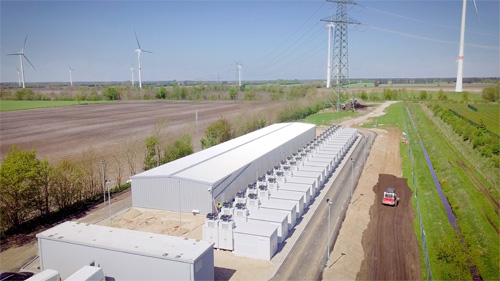ProCom software for frequency control reserve optimizes the EnspireME 50 MWh electrical storage facility
Aachen (Germany), February 6, 2019 – With over 50 MWh capacity and a maximum output of 48 MW, the electrical storage facility of EnspireME, a joint venture of the Eneco Group and Mitsubishi Corporation, is the largest battery system in continental Europe. It is an important support for the electricity grid. By providing frequency control reserve (FCR) and reactive power, the Battery Energy Storage System (BESS) located in Jardelund, Germany, contributes to grid stabilization.
The BESS can feed up to 48 MW of power into the electrical grid of network operator TenneT, or take electricity from the grid of which 38 MW is qualified for FCR. That minimizes the use of fossil-fueled power plants for instantaneous frequency stabilization. Paul Smeets, Head of Short-Term Electricity Trading at Eneco: "In terms of availability, provision of instantaneous power and fast response time, batteries are ideal for fast stabilization of the electricity grid. And they have lower environmental impact and less efficiency-loss than the plants that are now typically used for FCR."
Installed in a building with a length of 70 meters and a width of 12 meters, the BESS is the first project of its kind carried out by Eneco and Mitsubishi Corporation. There were some challenges in the design, planning and implementation process, and the economic viability analysis was not easy, says Smeets. "The profitability depends largely on the potential revenues for FCR. But before commissioning the BESS, we had very little experience in this market." In addition, implementation of the project was only possible with the aid of competent partners, including battery specialist NEC Energy Solutions, transmission network operator TenneT and software supplier ProCom.
BESS has been officially online since the end of May 2018, and has been able to feed the targeted maximum power of 38 MW into the grid occasionally. "Of course, the maximum possible power is not the only thing that matters – FCR has to be provided for longer periods and with extremely high reliability," says Smeets. For that reason, the battery system is not marketed to its full capacity as part of the capacity is required to (re)charge the battery. "This way we can also meet our delivery promises even when one of the total of 22 battery modules is out of service for maintenance."
Automatic management of the battery system with ProCom software
Due to the high requirements for reliability, nearly all processes are automated. Trading, supply, deployment planning or nomination are software-assisted, and charge management of the BESS is automatic. A ProCom solution specifically adapted to the battery system optimizes the battery charge state. Without this automated software-based management, the BESS could be overcharged or not charged enough to provide FCR. "You never know if positive or negative FCR will be requested, which means charging or discharging the batteries," comments Smeets.
For battery management, the ProCom BoFiT software analyzes whether the charge state is within the specified tolerance range. BoFiT also evaluates the energy flows. If the charge state of the BESS threatens to leave the tolerance range, the software calculates the electricity purchase or sale necessary to counter this and automatically generates proposals for intraday trading. For this the software takes into account the duration of the charge or discharge process and determines the appropriate time window for the upcoming electricity trading, so that the trading transactions can be made under the best possible conditions.
The proposals for intraday trading generated by BoFiT are sent directly to Eneco's trading department. From there they are also conveyed to the market without manual interventions. This also includes profitability optimization. The first priority is the provision of FCR. The technical restrictions of the plant, such as maximum current flows, charge curves and many other factors, must also be taken into account.
Profitability from provision of FCR and reactive power
Along with FCR, the BESS provides reactive power. It can additionally be used for secondary control reserve (FRR), for pooling or, for example, marketing in intraday trading. The battery can also store electricity from nearby PV farms and wind farms when it cannot be fed into the grid due to network capacity limitations. This application is intended to be tested in the WTSH subsidy program; a study about "Optimizing of Wind energy production by involving innovative Li-Ion Battery Technologies". The project also takes part in the NEW4.0 subsidy program. The focus of this Work Package is to define the future Reactive Power product technically as well as the market around it taking regulatory changes into account. For this reason the project is being supported by the Innovation Alliance Norddeutsche EnergieWende, Sinteg Smart Energy Showcases and the State Program for Enterprise.
After more than six months of operation, it is clear that operation of the battery system is working as expected with fully automatic battery management and software-assisted planning making a substantial contribution to its cost-effectiveness.
Pictures
The EnspireME Battery Energy Storage System (BESS) in Jardelund (image source for all photos: Eneco)
Press and public relations:
ProCom GmbH
Anke Dieterich
Luisenstrasse 41
52070 Aachen
Germany
Phone +49 241-51804-105
Fax +49 241-51804-30
Anke.Dieterich@procom.de
www.procom.eu
Press'n'Relations II GmbH
Ralf Dunker
Graefstrasse 66
81241 Munich
Germany
Phone +49 89 5404722-11
Fax +49 89 5404722-29
du@press-n-relations.de
www.press-n-relations.de

